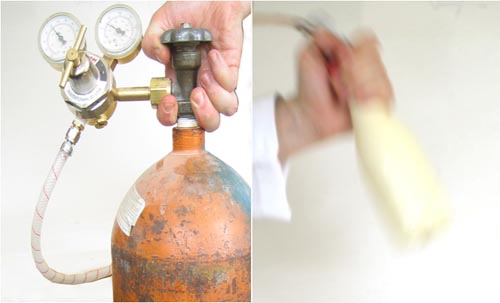posted by Dave Arnold
Happy New Year. If you are more interested in a bottle of bubbly than in bubbles, perhaps I can interest you in one of our old posts, a tutorial on how to saber a bottle of bubbly.

Everyone here at Cooking Issues is a huge fan of bubbles.  Let’s just say we know from carbonation. When some new science came out a few months ago on the taste of bubbles, we were intrigued. The Taste of Carbonation, in the October 2009 issue of Science Magazine, describes carbonic anyhydrase 4, an enzyme that allows us to taste CO2 (carbon dioxide –the bubbles). For those of you not hip to science publishing, getting an article on bubbles printed in Science is a big, big deal. The theory: In your mouth, CO2 is converted into bicarbonate ions (HCO3-) and protons (H+). The protons are acid, and are sensed by your sour receptors. That’s it. Mice that had no sour receptors had no response to the carbonation, and mice that didn’t have the enzyme couldn’t taste carbonation. This research came about, in part, because a scientist who was also a mountainclimber was taking the anti-altitude sickness drug Acetazolamide, a carbonic anhydrase inhibitor, and noticed champagne tasted like crap and figured there might be a link between carbonic anyhydrase and the taste of CO2.
This research made me hopping mad. For years I have been railing against the long-standing explanation that carbonation’s taste comes from acidity. The tired, old explanation is that CO2 dissolves in water to form carbonic acid. Somehow, the combination of bubbles plus the cabonic acid makes the taste of cabonation. That is rubbish. First, most CO2 does not get converted to cabonic acid –it exists as dissolved CO2. Second, If you drink seltzer in a hyperbaric (high pressure) chamber where there are no bubbles, it still tastes like seltzer. Third, and most important to me, I can put N2O (nitrous oxide) bubbles into a highly acidic beverage like lemon juice and water, and it doesn’t taste like seltzer with lemon — it tastes like lemonade, because nitrous tastes sweet.Â
This research brought the whole argument back to acidity. I was dumbfounded. I mean, selzter tastes like selzer, not like acid. I called up Dr Charles Zuker, one of the senior authors on the paper, who just moved up the street from me to Columbia University. Our converstion went like this:
 “What is the deal?”
“Well, CO2 is perceived as acidity. If you blow pure CO2 onto your tongue you percieve acidity before you percieve pain. CO2 also stimulates pain receptors.”
“Why doesn’t lemonade with nitrous taste like soda?”
“Ahhh. When you drink lemonade with nitrous, the acidity is sensed all over your tongue at the same time at the same concentration. When you drink lemon soda, the acidity levels change all the time all over your tongue due to the activity of the carbonic anhydrase enzymes. The random, changing pattern of acidity on your tongue is percieved in your brain as carbonation.”
“So if I could make a drink with tiny pockets of acidity it might taste carbonated?”
“Yes.”
Wow. That was some food for thought. I’m still digesting it.

Happy New Year Dave!!
Thanks Patricio, you too.
So, if I am reading this right, then wet milling some (for example) citric acid in a neutral oil – and this may need to also be sonicated for a while as well – it may give the impression of a carbonated oil?
That alone would be enough to get me to go buy a mill!
Dunno Chris,
We were wondering the same thing. The other question I had is if the creation of the protons by the enzyme has a specific rate. Is it only the pattern, or also the attack of acidity that causes the sensation?
Heh. Now I need to go and dig up the article. My lab will be amused (we do vision research, but we have a tradition of sharing weird articles in Nature and Science). By our standards, this qualifies.
I haven’t read the Science article, but…
“When you drink lemon soda, the acidity levels change all the time all over your tongue due to the activity of the carbonic anhydrase enzymes. The random, changing pattern of acidity on your tongue is percieved in your brain as carbonation.â€
I think the idea here is the tongue knows where the carbonic anhydrase is. If the tongue senses acidity everywhere it tastes “sour”, if it tastes it co-localized with the enzyme, it tastes “carbonated”. When Zucker said “changing” I think he meant changing in space, not in time. Your plan to create “tiny pockets of acidity” will only produce carbonation if you can target those pockets to the locations of carbonic anhydrase.
Your brain decodes aromas in the same way. Any given oderant likely causes quite a few different receptors to be activated. A different oderant may overlap with some of those receptors. It is the *set of receptors* activated at the same time that the brain uses to decode an odor.
As I think about this, there is a problem. In a carbonated liquid at steady state (e.g. that’s been sitting in a bottle), addition of the enzyme carbonic anhydrase will not change the concentration of protons (acidity). Your report of Zucker’s explanation does not make sense to me.
I suppose it is possible that as you drink a carbonated beverage, two things could happen to drive out dissolved CO2: 1) since the CO2 partial pressure above the beverage is lower than equilibrium (what was in the bottle), that the agitation of drinking it may drive out CO2. 2) The heat of your mouth may help drive out CO2.
In this case the presence of carbonic anhydrase would hasten the conversion of carbonic acid into H2O and CO2, and hence LOWER the acidity, not raise it. Your tongue would have to correlate lower acidity with the presence of the enzyme.
The carbonic anhydrase isn’t added. It is present on your tongue. The enzyme, according to the article stays put near your sour receptors and turns CO2 into bicarbonate and protons. The reaction happens on your tongue. There is always excess CO2 in carbonated drinks. That is why they effervesce. The carbonic anhydrase doesn’t convert carbonic acid into CO2 and water, it converts CO2 into HCO3- and H+. The total reaction is H20+CO2 In the presence of carbonic anhydrase yields H+ and HCO3-.
When I spoke to Zucker, he implies that both spatial and temporal issues play a part.
Thanks for the reminder on which step the carbonic anhydrase catalyzes (actually, the full equilibrium set of reactions is {H2O + CO2 H2CO3 H+ & HCO3- 2H+ & CO3–}, the enzyme catalyzes the second step).
I said “added” to describe the situation in generic terms. In the example, the solution containing CO2, H2CO3, H+, HCO3-, etc. is “added” to the carbonic anhydrase by putting it onto the tongue, so it’s the same thing.
Nevertheless, my point remains the same. The presence of an enzyme does not change the concentration of any of the species when things are at equilibrium. http://en.wikipedia.org/wiki/Enzyme#Thermodynamics I don’t see any way the enzyme could increase the local acidity. It seems possible that it could *decrease* the local acidity. I’ll have to get the paper.
Let us think about a bottle of selzer. Inside, H20 and CO2 molecules are interacting to produce H+ and HCO3-. Being at that both the forward and backward reaction are proceeding at the same rate, the system has a net pH of (approximately) 4. Addition of an enzyme to this system will not alter the pH, as it is at chemical equilibrium. However, once the bottle is opened and the liquid is introduced to a new system (your mouth) many reactions occur, including the production of new H+ ions, ready to trigger the sour taste receptors.
Also, enzyme is actually anchored right to the sour receptors, which would create the tiny “pockets of acidity”.
Sorry, it looks like my attempt at double-headed arrows got stripped out of my reply. The reactions are as follows, using the tilda as a double-headed arrow:
H2O + CO2 ~ H2CO3 ~ H+ & HCO3- ~ 2H+ & CO3–
Hey dizave. Have you done the miraculin test with CO2? When we ate the dehydrated fruit I think we used the chi water (nitrous/CO2 mix) to cleanse rather than CO2. What does Gymnimic acid do to straight nitrous? Just curious.
Excellent questions my man. How was the egg nog?
Dave-
You seem like you have played around alot with injecting CO2 and N2O into different liquids… have you ever tried putting other gases such as O2 or N2 into a liquid (or Helium for a Willy Wanka “Fizzy Lifting Drink”, lol)? They might impart other flavors as well.
Howdy Jimmy,
The great thing about CO2 and N2O is their solubility. I wish you could get enough Helium into a drink to change your voice! Nitrogen is used in beer-gas to give high pressurization at low carbonation levels in beer lines. If you applied straight CO2 at the pressure necessary to get your cold plate system working, the beer would have too many bubbles, so you add insoluble Nitrogen. Oxygen has a relatively low solubility, but my impression is that O2 levels in liquids play a huge role in the flavor of beverages like tea. Might be a good avenue for exploration.
Dave,
Me again. If this is too boring or whatever let me know (or don’t approve the comment) and I’ll stop replying.
Anyway, I finally read the article, and unfortunately it doesn’t test your pet peeve. They show that knocking out sour-tasting cells–or the ability of those cells to signal–blocks the taste of carbonated water, but they don’t test whether carbonic anhydrase is involved in that. The carbonic anhydrase (CA) experiments only test whether the tongue can detect CO2 gas (i.e. not dissolved in water) in the absence of CA (it can’t). IMO the tongue is not where you perceive gaseous CO2, regardless of whether it is able to do so (I perceive it in my nasopharynx), so the impact of this finding is minor and not related to carbonation.
I have written to Zuker with these comments, though I’m expecting he won’t reply.
Hi,
First, a very neat blog :-). Thanks for going in-depth at Cooking Issues.
Well, I just wanted to point out that normal (non-nuclear) chemistry can’t produce protons. H+ is used only for convenience in chemistry. The culprit responsible for the acidity you speak of is the hydronium/oxonium ion: H3O+.
Thank you for the sensible critique. Me & my neighbor were just preparing to do a little research about this. We grabbed a book from our area library but I think I learned more from this post. I’m very glad to see such excellent info being shared freely out there…
Thanks.